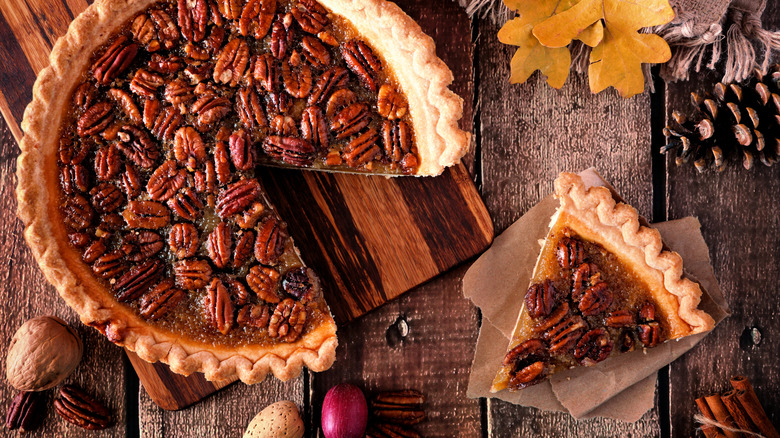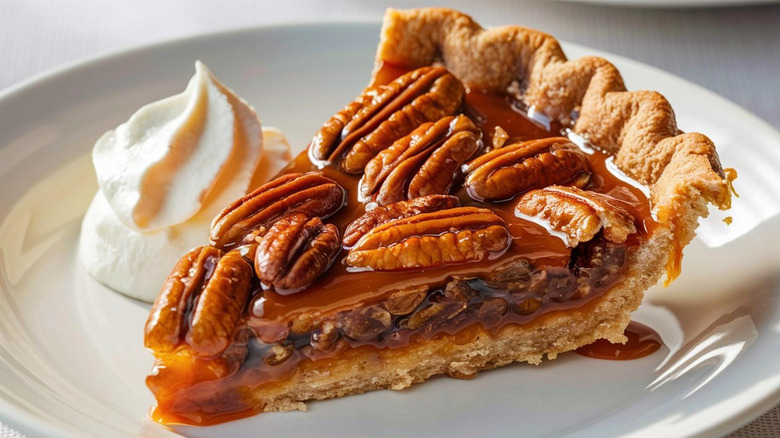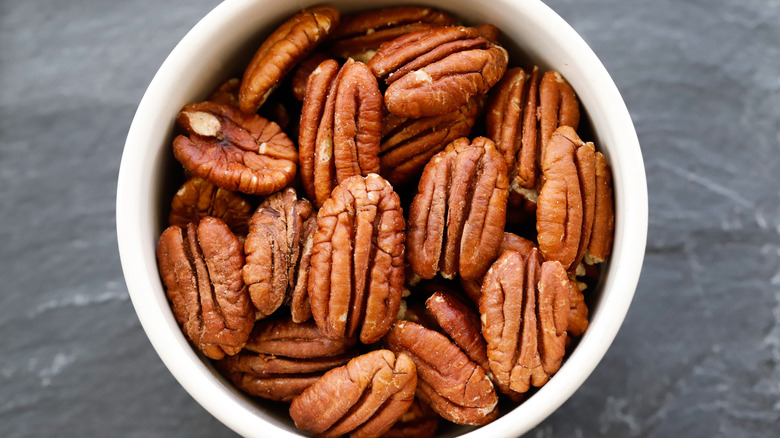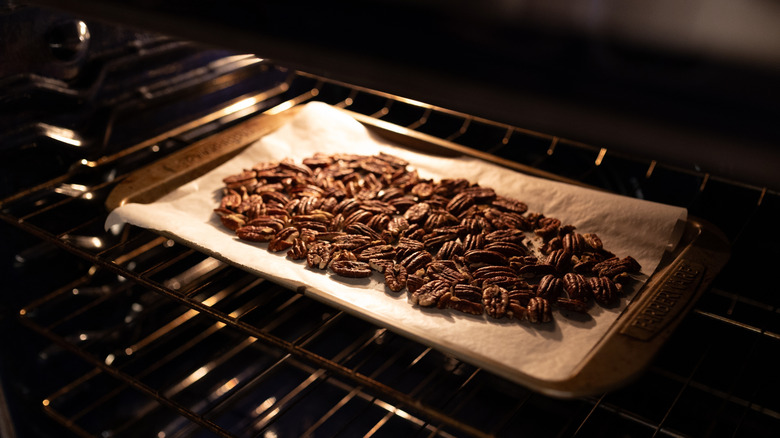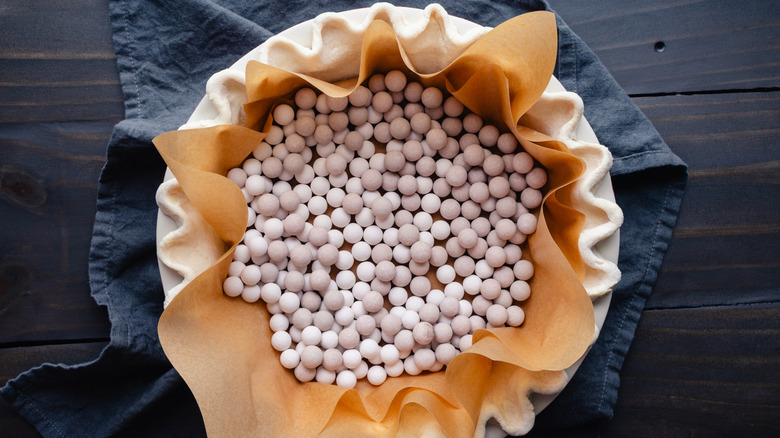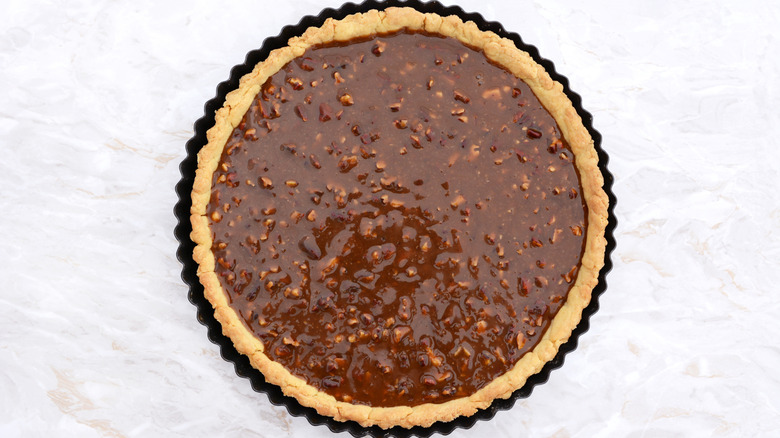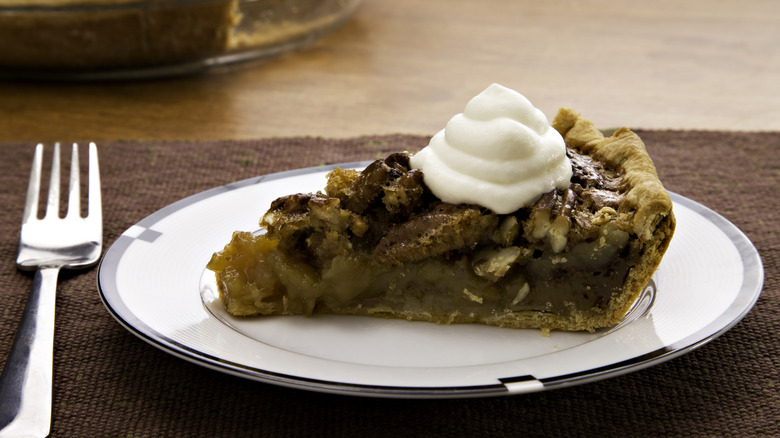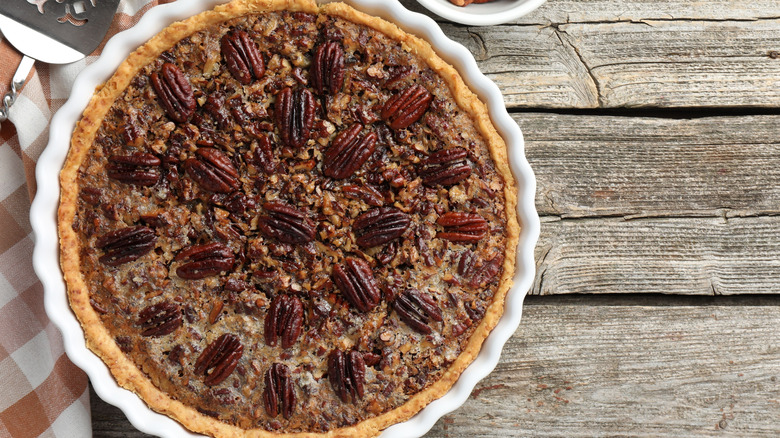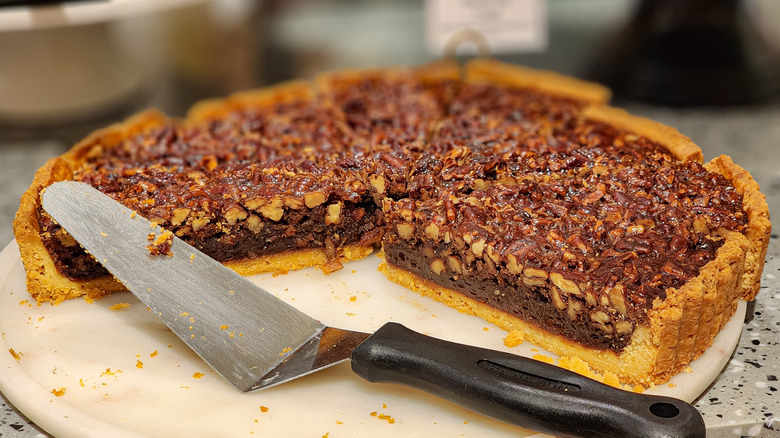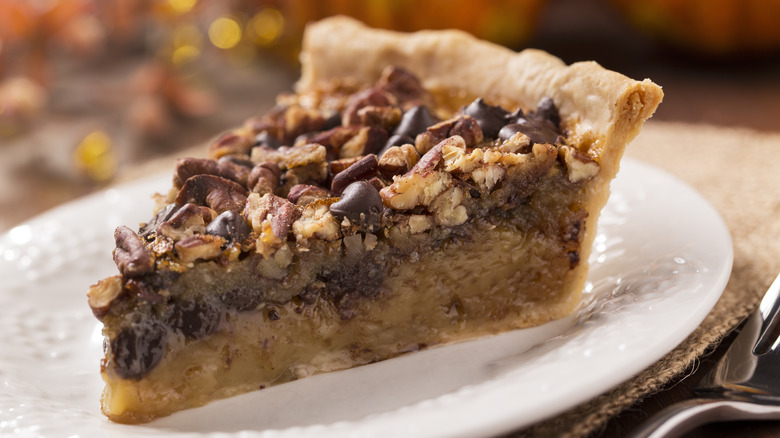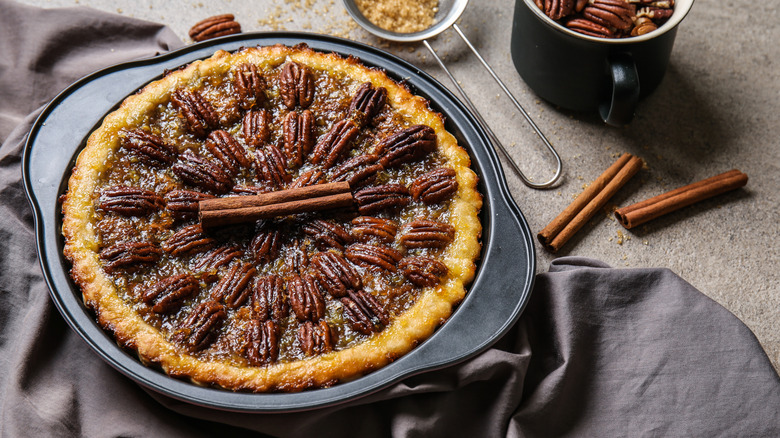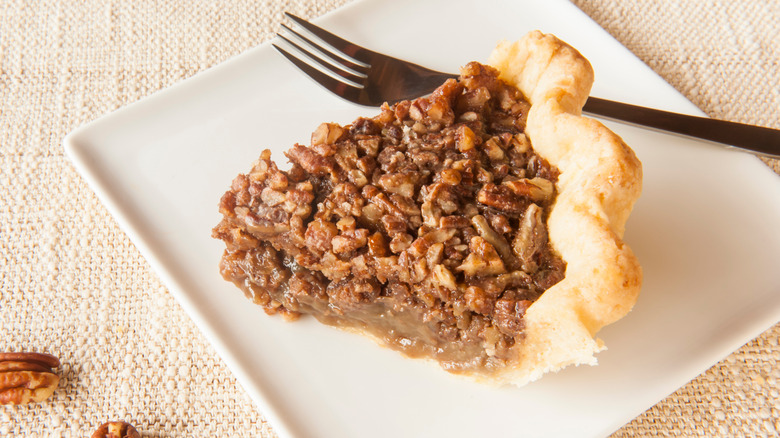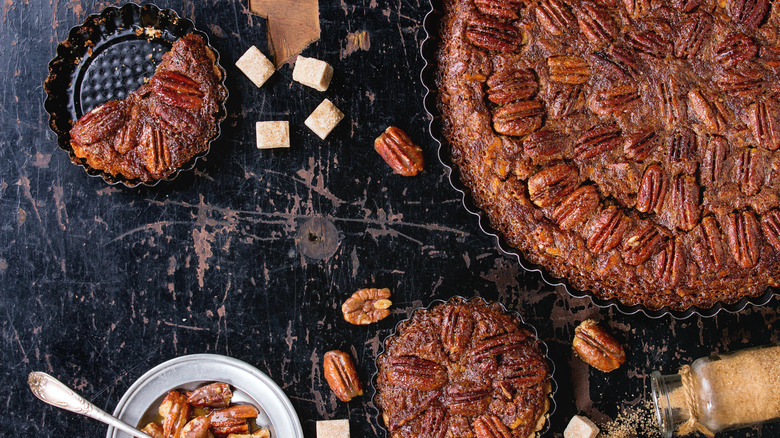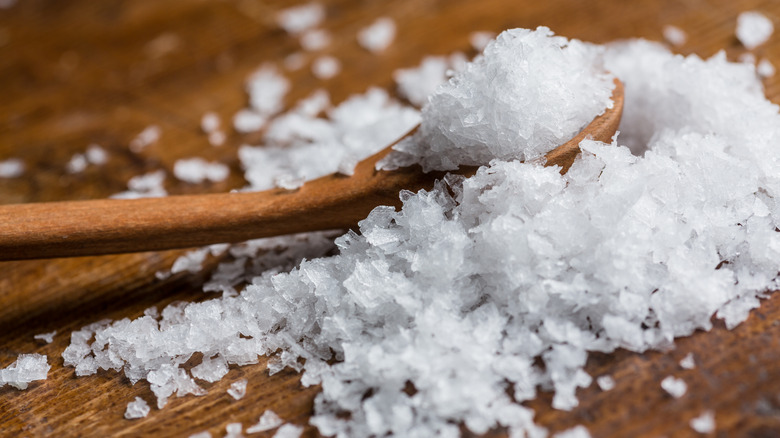Mistakes Everyone Makes With Pecan Pie
Pecan pie is an American classic that's popular on the Thanksgiving table and beyond. Rich with tradition and unapologetically indulgent, it's as much a cultural symbol as it is a sweet treat. Still, for all its straightforward ingredients — pecans, sugar, butter, and eggs — this pie can be surprisingly temperamental. Even experienced bakers can find themselves facing a runny filling, soggy bottom, or pecans that are more burnt than caramelized.
The trouble is, there are all kinds of places where things can go wrong. The filling should have a custard-like consistency that holds its shape without veering into gelatinous territory. The pecans should toast gently in the oven, releasing their natural oils and lending depth to the sweetness below. And the crust, often an afterthought, must remain crisp enough to cut cleanly and hold the filling. Achieving all this takes more precision than the recipe might suggest.
There are all kinds of errors you can make, from forgoing the blind baking step to missing out some easy ways to upgrade your pie, like toasting the pecans or adding a boozy hit. In this article, we'll explore the most common missteps in making pecan pie and, more importantly, how to avoid them. After all, the difference between a good pie and a great one is in the details.
Making the crust dry
One of the most common mistakes people make with pecan pie is baking a dry pie crust. Even if you get the filling perfect, your pie's never going to achieve greatness. There are several ways you can wind up with a dry crust.
A frequent reason for this is measuring ingredients incorrectly. Flour, in particular, is easy to overdo if you're scooping directly from the bag instead of weighing it or fluffing it before measuring. Even an extra tablespoon or two can make your dough crumbly. But, preventing dry pie dough goes beyond proper measuring. Water is also critical, and too little can leave you with a crust that's impossible to roll out evenly and prone to cracking. Adding water gradually is key, but don't be afraid to test the dough with your hands — it should just come together without feeling sticky or falling apart.
Then there's the butter. Too little can make your crust dry but temperature matters, too. You need cold butter to create the flaky layers that make a great crust. If the butter softens too much, or if it's not properly chilled to begin with, it blends too seamlessly with the flour, resulting in a dense, dry texture. Lastly, make sure not to overwork the dough. Every extra press, roll, or knead builds gluten, turning what should be a crisp, tender crust into something chewy and dry. Handle it just enough to bring it together, then let it rest before rolling.
Using old pecans
The pecans you choose for your pie can determine whether the filling is rich and delicious with a nuanced putty flavor, or a stale disappointment. While it's tempting to rely on that bag of pecans you've had languishing in the pantry for years, freshness is important when these nuts are playing a starring role. So, avoid the common mistake of using old pecans.
Even if they look fine, pecans that are past their best can be bitter or lose a lot of their flavor. Nuts are high in oil, and over time, those oils oxidize, turning them rancid. This isn't always immediately obvious when you're preparing the filling but becomes unmistakable once baked, adding an unpleasant undertone no amount of sugar and syrup can mask. But when pecans are fresh, they're incredible. They have a buttery sweetness that shines through the intense filling.
So, always buy fresh pecans for this dish. Ideally, buy them from a store that has a high turnover. If in doubt, look at their use-by date and choose one as far away as possible. Better yet, buy from a farmer's market or specialty store.
Not toasting the pecans
If you're skipping the step of toasting pecans before making pecan pie, you're missing out on an opportunity to take your dessert from good to exceptional. Raw pecans might be naturally sweet and rich but they can feel one-dimensional when baked directly into the pie. Toasting, on the other hand, transforms them. It deepens their flavor and adds a complexity that balances the sweetness in the rest of the pie.
Just being heated for a few minutes makes pecans undergo changes that transform their flavor — just like toasting bread. You might think that the pecans will toast in the oven when you make the pie, anyway, but this isn't the case. The ones right at the top might toast slightly, but any deeper in the pie will be insulated by the filling and won't get toasty.
The process is simple but requires attention. All you need to do is heat your pecans in a dry skillet or oven for a few minutes — not long enough to scorch them but just enough to turn their color a shade deeper. The nutty aroma alone will tell you when they're ready. When you use raw pecans, they can come across as flat in comparison. Plus, you don't get the crispy texture that complements the silky filling. Toasting is a small effort that's absolutely worth the time it takes.
Pouring the filling into a raw crust
Pouring pecan pie filling into a raw crust and baking it all at once may seem convenient, but it almost guarantees a soggy bottom. This classic dessert's filling is rich and liquid-heavy. As it bakes, that moisture seeps into the dough, leaving it pale and soft where it should be crisp and flaky. To avoid this, you need to blind bake the crust. This step adds a little time but helps your crust hold up and come out perfectly crisp.
For those not in the know, blind baking means partially or fully pre-baking the crust before you add the filling. After rolling out your dough and fitting it into the pie dish, you line it with parchment paper or foil and fill it with pie weights. You can buy ceramic baking beads for the task, but dried beans or uncooked rice work, too. These weights keep the crust from puffing up as it bakes. The crust goes into the oven for about 15 minutes, until it's lightly golden.
It might seem like this is an unnecessary step that just gives you more work but it makes a huge difference. Although some recipes skip the blind baking step, we wouldn't recommend this. It's a route to disappointingly limp pastry that can ruin your pie.
Overfilling the pie dish
Overfilling a pecan pie might seem harmless. After all, who wouldn't want a little extra filling? But when you pour too much filling into the crust, you set yourself up for an array of issues, starting with the bake itself. It's better to show a little restraint.
A pie that's overfilled can struggle to bake evenly. The center may remain undercooked and runny, while the edges start to overbrown. This uneven texture takes you away from the smooth, custard-like consistency that makes pecan pie so great. What's more, as the filling heats, it expands. If there's no room for that expansion, it can spill over the edges, burning onto your oven floor and leaving the crust with a sticky, charred rim.
The fix is simple: resist the urge to push your pie to the brim. Leave a little space at the top of the crust. Around ⅖ of an inch is the sweet spot. This gives you enough room for the filling to expand without spilling while making sure the pie won't seem underfilled.
Underbaking it
Underbaking pecan pie is one of the most common pitfalls, and the consequences are hard to ignore. A pie pulled from the oven too soon often has a filling that never fully sets. Instead of the smooth, custard-like consistency you're aiming for, you'll cut into something runny that spills across the plate. Beyond the filling, an underbaked pie often leads to a soggy crust. The moisture from the filling seeps into the dough so it doesn't stay crisp after baking.
To avoid this, you need to bake the pie properly. You need to learn how to tell when a pecan pie is done baking. Yes, you can cook it exactly as long as the recipe says but this won't always give you the perfect results as there are so many factors at play.
The simplest way to check for doneness is the jiggle test. About five to 10 minutes before you think the pie might be done, open the oven, and gently nudge the pan. Look closely at the center — it should jiggle slightly, like Jell-O, while the edges stay firm. If the entire pie moves in waves or appears wet in the middle, it needs more time. It might seem like a jiggling pie would be underbaked, but the residual heat will keep cooking it until it's perfectly done.
Overbaking it
Just as common as underbaking pecan pie is overbaking it. If you wait until the pecan pie seems fully set in the middle, it will actually come out overdone. That's why checking for a jiggle, as instructed above, is the way to go. You can also look out for a slight puffiness near the crust and a golden brown color.
But why is it so bad to overbake pecan pie? Even when it's not so overcooked that it's noticeably burned, it can cause problems. One common result is graininess. When baked too long, the custard begins to curdle, causing the smooth texture to break into unpleasantly gritty bits. These are essentially tiny bits of scrambled egg. Not ideal.
Cracks are another telltale sign of overbaking. As the filling cools, it contracts. If it's been baked too long, the surface dries out and splits. Overbaking can also harden the filling. Instead of a soft, sliceable custard, you're left with something closer to brittle candy. So, check your pie for doneness regularly to avoid baking it too long.
Not considering alternative sugars
While there's nothing wrong with sticking to traditional pecan pie recipes, it's worth considering alternative sugars. Recipes usually call for a fairly large quantity of corn syrup, but there's one ingredient swap you should consider with pecan pie. Instead of using corn syrup, try maple syrup instead.
Corn syrup brings little beyond sweetness and stability to a pecan pie. But using maple syrup introduces more in the way of flavor. It has notes of vanilla, smoke, and earth that can add more than just sweetness to the recipe. Dark maple syrup, harvested later in the season, works particularly well. Its robust flavor stands up to the toasted pecans in a way that corn syrup can't.
Using brown sugar or coconut sugar instead of white sugar further deepens the pie's flavor. Brown sugar has a subtle caramel note and a hint of molasses. Coconut sugar adds a butterscotch undertone that particularly complements pecans. If you sometimes find the one-note sweetness of pecan pie too much, this is a switch to consider.
Being too traditional with the ingredients
Of course, pecan pie is great in its most traditional form. But sticking too rigidly to tradition can be a missed opportunity. There's room to experiment, to play with the foundational elements, and create something different. Being too traditional can close off these opportunities to explore what else pecan pie can be.
One thing to consider is adding a touch of heat. A few dried chilies bring a smoky warmth that cuts through the sweetness. The heat isn't overwhelming. Instead, it's just a gentle background warmth. And it's an expert-approved tip, too. Joanna Gaines' pecan pie has an unexpected twist from chilies. Chocolate is another ingredient that pairs beautifully with pecans. A modest swirl of melted dark chocolate or a handful of finely chopped chocolate mixed into the filling deepens the richness. Coconut is another great choice. It offers a contrast to the nuts and fills in the gaps left by a more straightforward pie. A bit of shredded coconut toasted in the oven alongside the pecans is delicious.
And don't overlook fruit. Raspberries or finely sliced green apples provide a slightly tart counterpoint to the pie's sweetness. Pineapple or mango bring the tropical vibes. You can experiment with practically any fruit and see what tastes good.
Choosing the wrong size of pie pan
Using the right pan size for pecan pie is more important than it might first seem. While it might seem logical that most pie pans are interchangeable, even a small change in size can have a significant impact on the final result. It's a mistake that's extremely common with inexperienced bakers.
If you use a pan that's too small, you'll have too much filling. It just won't fit in. Trying to fit in as much as possible might result in filling spilling out or underbaking the pie because the thicker filling needs longer in the oven. On the other hand, using a pan that's too large means you won't have enough of anything. You won't have as much pastry as you need to fully fill the pie pan and the filling will be spread too thinly. It might cook quicker and end up overbaked and cracked or grainy.
To avoid these issues, follow the recipe's pan size recommendation. A 9-inch pie pan is most common, but don't assume. Some recipes use bigger or smaller pans. If you don't have the pan size you need, either use a different recipe or find a reputable recipe converter online.
Using pecan halves
For some people, using whole pecan halves instead of chopped pecans is a mistake. Ree Drummond, for one, is an advocate for chopped pecans in pecan pie. It's worth noting that not everyone agrees with this. Some people are team chopped pecan all the way, while others would go out fighting for pecan halves.
There's a clear argument for using chopped pecans: they distribute more evenly throughout the filling. This helps ensure each bite has an even mix of nuts and custard. Chopped pecans also make the pie easier to slice. If you've ever tried to cut pecan halves without making a mess of things, you'll understand. The smaller pieces meld into the filling, giving you a cohesive texture rather than one that's interrupted by large whole nuts.
However, whole pecans have their advocates. Some people love the look of whole pecans arranged in a decorative layer atop the pie. Others also appreciate the contrast between the nuts and custard. So, it's not as simple as saying that using pecan halves is definitely a mistake. It's worth trying both ways and seeing which one you prefer.
Forgoing alcohol
Think pecan pie doesn't need booze? Think again. Always forgoing alcohol when you're making it is a mistake. We're not saying that every pecan pie must be boozy, but there are some great variations with alcohol that are worth trying. You don't need to use a huge amount, just a splash. This way, you get the flavor from the alcohol without the burn.
Rachel Ray's husband can't get enough of pecan pie with a double shot of bourbon. And we can see why. The sweet, smoky notes of bourbon are a perfect complement to pecan pie. Ray's recipe also uses brown sugar, which adds more deep caramel notes to the dessert. Sounds dreamy.
Ree Drummond uses booze in her pecan pie filling, too. She also opts for bourbon. However, this certainly isn't the only choice for pecan pie. Dark rum brings a complex sweetness to this classic dish, while a good quality gin has a slightly astringent quality that helps balance out the intense sweetness. You could also opt for liqueurs, such as Bailey's Irish cream, coffee liqueur, or an orange liqueur like Grand Mariner. The malty notes of a stout or similar dark beer could work nicely, as well.
Not sprinkling on some salt before serving
Adding a small sprinkle of salt on top of a pecan pie before serving might seem like an afterthought, but it's a step that adds an unexpected depth to the dessert. Most people don't think to use salt in this way. But this is a mistake you should rectify. It makes more of a difference to the finished dish than you might realize.
The contrast between the pie's sweetness and the salt helps balance the flavors, cutting through the richness of the filling. Without this touch, pecan pie can sometimes feel overly sweet or one-dimensional. But even just a hint of salt sharpens the overall profile, providing just enough contrast to highlight the more subtle notes in the filling.
Salt also gives you some added texture on the pie's surface. When lightly sprinkled on top, it lends a crunch, which creates a contrast to the texture of the filling. Consider using a flake salt, like Maldon, which dissolves easily and has a more delicate, nuanced flavor than table salt. It might seem like a small step, but it's one of those touches that can truly elevate your pecan pie.
